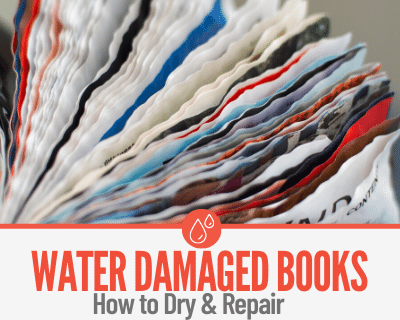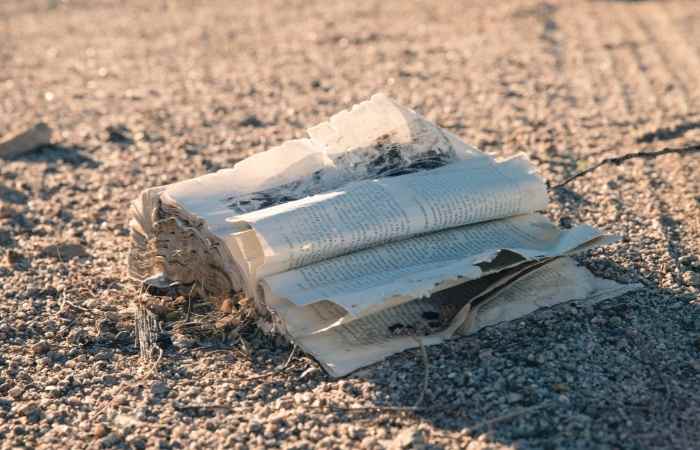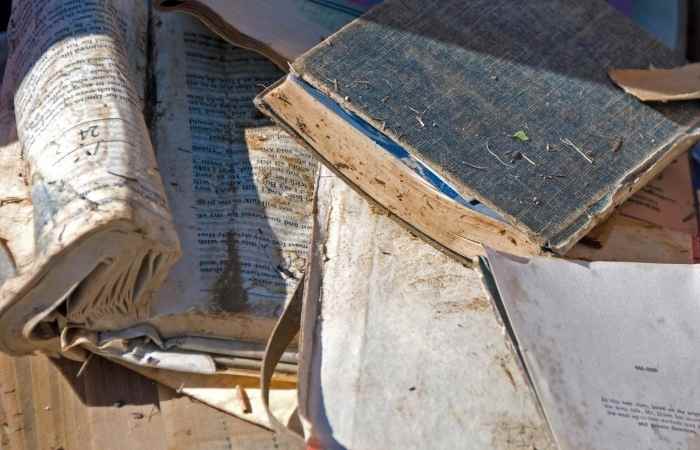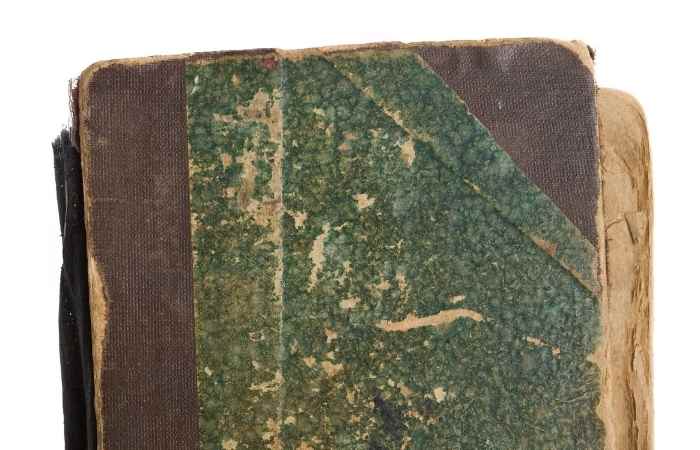Of all the worst types of damage that can occur to books, water damage is definitely right up there at the top of the list.
Damage might include soggy pages that are stuck together, ink running all over the pages and even pages tearing off.
Is it even possible to save them?
In this guide, we will look at some of the causes of water damage to books, how you can prevent them and what you can do to save books have already been damaged by water.

Books, whether old or new, can hold way more value than simply their replacement cost alone.
For example, they may hold sentimental value or important, useful information that we need like a favorite, much loved recipe book.
They might be particularly rare finds such as books that are no longer in print or they might be valuable and collectable first editions.
Water damage to precious books can be devastating.
Can Water Damaged Books be Dried & Restored?
Water Damaged Books Can Absolutely be Dried and Restored in most cases if done fast enough and with the right method.
The success rate will depend on:
- The type of water damage the books have suffered,
- How fast they are dried out in case of a sudden water damage,
- How long have they been stored in damp conditions,
- If there are any Signs of Mold growth,
- The type of Paper the books are made from,
How Books Might Get Wet
Books might get wet in various ways.
They might be affected by flooding, along with other possessions, which is upsetting and difficult to deal with.
Other ways books commonly get wet is via common storage methods.
Damp basements and attics with issues such as leaky roofs, broken pipes, extra humidity, fluctuations in temperature and other damp conditions can all affect books, especially when they take place over a prolonged time.
We might only damage an odd book, such as dropping a text book for school or college in a muddy puddle or we might even drop our book in the bath or spill a drink all over it.
Whatever the cause, the outcome is not good for books that become wet so you do need to act quickly and appropriately.
First, Assess the Damage
Books that are extremely rare or valuable should be firstly assessed by a trained conservator before you attempt to dry them yourself.
Library books may also require special care so contact your library first for advice.
Try to assess the damage for each book separately and treat accordingly. Read on for specific guidance in each kind of situation.

What to do in case of Contaminated Water
Books that have been damaged by contaminated water, for instance floodwater, need extra careful handling if they are to be saved.
The procedure might sound counter-intuitive ,however this is the best way to save a book that has been in a Contaminated dirty water or any other liquid.
You should wear household rubber gloves, as there may be bacteria present.
First, fill a sink with fresh, clean water.
Hold the book firmly closed by the spine at either end so extra water cannot get in and then run the book through the sink water in one clean, fluid, motion-sweep action.
This is to remove all surface debris. Remove the book at once and gently remove any other large debris you can see.
You can now follow the procedure below for drying soaking wet books.
Drying Soaking Wet books
Books which have been thoroughly soaked in standing or running water more than halfway through will need prompt attention and special care.
You need to get all excess water out as soon as possible.
Set Up Your Drying Area
Before you start, set up a large area for drying the books.
You ideally want this to be somewhere that can be left undisturbed, possibly for several weeks, while the books are drying.
You can use a large table, even, flat surface or even a floor area that is dry and out of too much direct sunlight.
What You Will Need
You will need the following;
- Large plastic sheeting or opened-up back bags to line the drying area
- A desk fan or ceiling fan located above the area
- Absorbent paper towels, (the more absorbent the better and plain white without print designs), hand towels and tea towels, tin foil, wax paper or bags (if freezing)
- Weights such as bricks, heavy ornaments or tin cans, bookends
Arrange the absorbent towels to be spread out on top of the plastic sheeting.
Important; When you are setting up your fan in the drying area, do not aim the stream directly at the books.
It is better to create good ventilation and air-flow throughout the whole room if possible by opening a window and positioning the fan nearby.
This will stop the books from warping or distorting.
Method
The first task is to drain excess water from the books.
- Gently wipe down (hardback) or blot (paperback) the books covers with paper towels to remove excess water
- Shake very gently when holding the spine, to remove excess water (in a fluid side to side swaying motion)
- Place the books with the top edge upright onto your drying area, standing them on the plastic sheeting and absorbent hand towels you have placed there
- If the covers are bleeding ink, place tin foil there to keep them apart from the rest of the book
- Use weights, cans or bookends to prop the book upright, tilted slightly so water can run down the spine and out, draining and dripping into the towels beneath
- Open the covers slightly but do not fan the pages or try to separate them yet
- Change the towels as required, repeat until towel underneath is dry
You can now follow the procedure below for drying wet books.

Drying Wet Books
Once you have removed all excess water by draining and dripping you now have a wet book.
The task here is to dry out and separate the pages without damaging the text or warping the paper.
In your drying area, prepare the wet book for drying.
- With the book laying flat, line the book covers inside and out with paper towels extending an inch outwards
- Insert further paper towels every 10-20 pages throughout the book (be careful not to place excessive strain on the binding)
- Change the paper towels as required once wet, changing the interspacing at intervals
- Leave for one hour then repeat process with book standing up
- Take patience and care to keep changing the paper towel sheets, repeat as necessary
You can now follow the procedure below for drying damp books.
Drying out Damp Books
There are a few methods you can use to dry out damp books.
They all require care and patience and varying amounts of time, from 20-30 minutes, to days, or to several weeks.
1. Air Drying with a Fan
This method is best for drying partially damp books but it will take time. In your drying area;
- Place book upright and open the covers to a 90° angle
- Allow the pages to fan out, creating air flow between
- Leave to dry in well ventilated area, spreading pages further as they dry to create more flow
2. With a Hairdryer
You can use a hair dryer on a low to medium setting to dry out partially damp books.
This is the fastest method but may also cause some damage so be careful.
- Work from the front cover to the centre of the book, then from the back cover to the centre
- Taking a few pages at a time, move the air flow from the dryer across the pages evenly in a downward motion from the top, as you would dry your hair
- Keep the air moving constantly to avoid burning or warping
3. With an Iron
This is another rapid drying method you can use for partially damp books but again will require care.
- Use tea towels to line the pages before running the iron over them, do not iron the pages directly
- Work slowly and carefully and keep the iron moving at all times
- Do a few pages at a time, working from front to centre then back to centre
4. Hanging Method
Partially damp books can be hung to dry in a well-ventilated area as above.
- Use string or wire and hang paperback books by their spine with the pages hanging freely
- Use two tables or other surfaces to spread out the covers of hardbacks with the pages fanned out and hanging beneath
This method will take longer, up to several weeks, but is less likely to damage the books.
5. Cornstarch Method
You can dry a damp book by sprinkling cornstarch between the pages and letting it sit in a plastic bag or covered box for a couple of hours.
The cornstarch will absorb the excess moisture.
When you remove the book, use a soft brush to clean up the cornstarch and repeat as needed.
6. Can I use a Microwave?
It is NOT advisable to dry books in any types of oven, including microwaves.
This can cause irreparable damage to the book and is a serious fire risk.
What to do in case of Severely Water Damaged Books
If you don’t have much time, you can buy some by simply freezing the wet books.
Freezing them will be helpful in preventing further damage and also the formation of mold.
Method to Freeze-Dry
- Blot excessive water gently with paper towels
- Wrap the book one at a time in wax paper or place in a zip-lock plastic bag. You want there to be air circulating in the bag, not a tight fit
- Place the book in the bag or wrap into a freezer making sure to shape the book into the correct shape as you place it
- Allow air around the book and leave for 24 hours, then open and brush off the ice from the inside of the wax paper (if using) then return
- Leave for around 1-2 weeks then defrost and follow the steps for drying a wet book above.
Restoring Wet Books with Mold
If not dried quickly enough, books may develop mold, which, sadly, can potentially ruin them forever.
Contact a specialist for advice about mold on valuable books.
If you can see growth of mold or mildew on your book’s hardback cover once dry, you can usually use a fine brush or very soft cloth to gently brush it away.
For a paperback book you can use a soft cloth lightly dampened with rubbing alcohol.
Use light, gentle strokes so you don’t damage the cover, and make sure that you blot away the excess liquid and dry the book thoroughly.
For cloth, leather, or other hardback types of cover, you can spot-clean with rubbing alcohol, but make sure to test an out-of-the-way corner first to check for discoloration.

Removing Mold and Mildew from the Pages of a Dry Book
Slide a sheet of wax paper underneath the moldy page to protect the page behind it.
As in the step above, use a soft brush to carefully remove any obvious mold or mildew.
Dampen a soft cloth with hydrogen peroxide or rubbing alcohol and carefully remove.
Removing Mold and Mildew from a Wet Book:
Do not attempt to brush or wipe mold off your damp books, as it will likely smear and stain the surface, as well as grinding it further into your book.
You should dry your book and then treat the mold problem afterwards.
If you are not able to work on drying and cleaning a damp book immediately, place it in a plastic zip-top bag and pop it in the freezer.
Let it thaw once you are ready to dry it fully as detailed above.
How to Fix a Wet Book That Has Dried
Once your books are dried, they still may not look quite like their old selves just yet.
They may be weird shapes or have some wrinkly, distorted pages.
Whilst your books may never be returned to their original condition, there is some further action you can take to help the situation;
- Place the fully closed book under a flat board and place heavy items such as bricks, evenly on top
- Leave for 24-48 hours, ensuring the spine is aligned at intervals
This process will straighten out most issues connected to crinkling and distortion.
In Case If You need to Unstick Dried Book Pages…
What should you do if your book’s pages have already dried and stuck together?
Fixing books that have already dried can be tricky.
Your best option is to use a water bottle to spray a fine mist to gently separate and then iron out the pages as you go.
Be sure to fold the paper flat and use a piece of parchment paper or a tea towel as a backing.
Depending on how badly the pages are warped, a shop press or a hair drier might also help.
If you need to Flatten A book Cover..
To flatten a book cover, follow the steps above to flatten out the book using evenly distributed weights on top. Or trying gently ironing as above.
How to Get Rid of a Smell from your Dried Books
Place any books that have a lingering odour into an airtight container with a lid and a cup of bicarbonate of soda.
Leave for 48-72 hours then check on the book. Repeat until smell is gone.
Prevention Works Best
Avoid water damage to your books by storing in plastic bags or boxes with lids that are airtight and waterproof.
Avoid, dark, damp or humid areas or areas at risk to leaks.
It is important that you assess your damaged books for the right method of drying, according to how wet they are, before you start.
You also need to consider the type of paper- coated or non-coated. Picture books are normally coated with a thin layer.
When to Call a Professional
In some cases, the damage to your books will be so great that you require the advice of a professional.
Get professional advice if you have large quantities of belongings affected by flood water.
Professionals can help you act quickly and advise what prioritise in an emergency when you are feeling overwhelmed.
